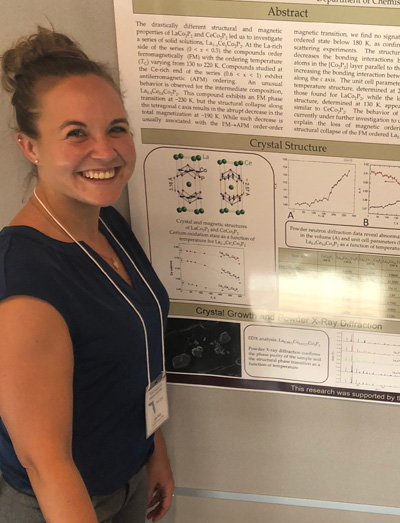
A Florida State University graduate student has earned an esteemed fellowship from the U.S. Department of Energy (DOE).
Judith Roth, a doctoral student in the Department of Chemistry, was one of 62 graduate students from across the nation selected for the DOE’s Office of Science Graduate Student Research (SCGSR) Program.
“Judy’s award is the recognition of her hard and creative work as a graduate student in our department,” said Michael Shatruk, a professor in the Department of Chemistry. “She has taken on a challenging project and already obtained some intriguing results, which strengthened her fellowship application. I expect her research will help us learn much more about the complexity of magnetic materials she’s studying in her thesis project.”
The SCGSR program provides supplemental funds for graduate students to conduct part of their thesis research at a DOE laboratory within a defined award period, which ranges from three to 12 consecutive months.
“These graduate student awards prepare young scientists for STEM careers critically important to the DOE mission and the advancement of American science and technology,” said Dan Brouillette, U.S. Secretary of Energy. “We are proud of the accomplishments these outstanding awardees have already made and look forward to following their achievements in the years to come. They represent the future leadership and innovation that will allow American science and engineering to excel in the 21st century.”
The goal of SCGSR is to prepare graduate students for science, technology, engineering or mathematics (STEM) careers important to the DOE Office of Science mission by providing thesis research opportunities through extended residency at DOE national laboratories. The research projects are expected to advance the graduate awardees’ overall doctoral research and training while providing access to the expertise, resources and capabilities only available at the DOE laboratories.
Roth studies solid state magnetism, and her research focuses specifically on frustrated magnetism and unconventional magnetic behavior. Frustrated magnetism is where conflicting atomic forces lead to complex structures.
She will complete her fellowship at the Oak Ridge National Laboratory in Tennessee over the course of six months, beginning tentatively Sept. 1.
“This award is going to be really helpful to my thesis because you can study magnetism well with the use of neutrons,” Roth said. “You can look at the actual magnetic structure and direction of your material. So being able to go to Oak Ridge National Lab and study fundamental magnetism with the use of neutrons is going to be huge for the development of my thesis.”
The Oak Ridge National Laboratory houses the Spallation Neutron Source, an accelerator-based neutron source facility that provides the most intense pulsed neutron beams in the world for scientific research and industrial development. Roth will use the Spallation Neutron Source to inspect five different frustrated magnet systems through the process of neutron diffraction.
Neutron diffraction uses neutron scattering, the irregular dispersal of free neutrons by matter, to determine the magnetic structure of a material. The process pinpoints how the magnetic moments interact with each other by producing a pattern from a crystal that allows researchers to look at different types of scattering, explain magnetic interactions and understand the quantum mechanics of magnetic behavior.
“In crystal structures, there’s a repeating pattern, there are atoms located at specific sites that repeat themselves in an ordered arrangement,” Roth said. “When you zoom in on my crystals, you’re looking at rare earth atoms, like cerium, lanthanum, erbium or ytterbium. Each of those atoms, if they have unpaired electrons, carry a magnetic moment, and that’s what we’re trying to see.”
Roth uses crystals to understand the magnetic moments and see how the neutrons interact.
“To understand the magnetic interactions that I’m looking for, crystals are necessary because you can understand if there’s a certain direction that the crystal needs to be oriented to get the most out of the magnetic behavior,” Roth said. “The only way you can really understand those directions and the magnetic interactions is with neutrons.”
The goal of Roth’s research is to understand the degrees of frustration within the five systems she’s studying and how the magnetic moments interact with those systems. Once the degrees of frustration have been determined, the fundamental magnetism that she studies can be used to improve technology.
“Magnets are used in computers for reading and writing memory (RAM),” Roth said. “Magnetic generators and motors are used for wind turbines and things of that nature. We can’t develop better technology for memory and thinner electronics until we can understand how the components work there, so my goal is to understand the magnetic strengths in Spintronics, which is used in the development of new technology for electronics.”
Roth credits her decision to attend FSU for graduate school as the main reason for her acceptance into this prestigious program.
“This is an awesome opportunity that I don’t think would’ve happened if I hadn’t come to FSU,” Roth said. “The amount of collaboration across different disciplines has been super helpful. Everybody has a genuine interest in discovering new things while working together, and I think that’s unique at FSU compared to other schools.”
To learn more about the DOE Office of Science Research Fellowship Program or similar awards, contact the Office of Graduate Fellowships & Awards. For more information about the Department of Chemistry, visit chem.fsu.edu. To learn more about the SCGSR, visit science.osti.gov.




